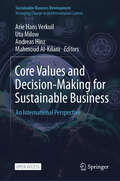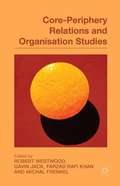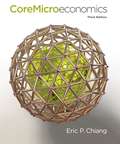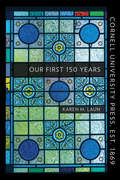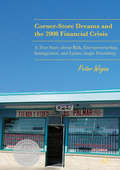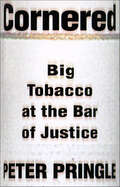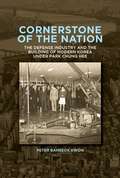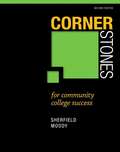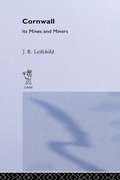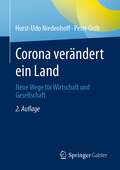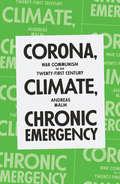- Table View
- List View
Core Values and Decision-Making for Sustainable Business: An International Perspective (Sustainable Business Development)
by Mahmoud Al-Kilani Arie Hans Verkuil Uta Milow Andreas HinzThis open access volume discusses the core values and decision-making for sustainable business in general, and includes research findings and country cases on addressing challenges. It emphasizes the importance of adapting products or services to local needs, considering cultural differences and sustainability. Some of the chapters address questions related to improving sustainability in micro, small and medium-sized enterprises (MSMEs), and cover circular economy and responsible consumption. Others look at the normative framework conditions for business development; sustainability in supply chains; the involvement of stakeholders and their influence on market presence; entrepreneurial decision-making for sustainability; and approaches to teaching international and sustainability-oriented entrepreneurship. The volume sheds light on the pivotal role MSMEs play in shaping a sustainable future and is written for researchers, practitioners, and students working on related topics.
Core-periphery Relations And Organisation Studies
by Gavin Jack Robert Westwood Farzad Rafi Khan Michal FrenkelCore-Periphery Relations and Organization Studies draws together postcolonial and indigenous thinking through the conceptual lens of core-periphery relations to advance debate in organization studies. A particular aim of this book is to broaden, deepen and critically reassert a postcolonial imagination in this domain.
CoreMicroeconomics (Third Edition)
by Eric P. ChiangWith this new edition, Eric Chiang transforms CoreMicroeconomics into a text/media resource well attuned to today’s students. Long active in the economics education community, Chiang brings a contemporary teacher’s perspective to the book, supporting a variety of learning approaches by introducing modern topics, new pedagogy, a more visual presentation, and well-integrated media tools. All this while maintaining the book’s defining focus on just those topics instructors cover most often in the course.
Corey Robinson at Sprint Corporation (A)
by Linda A. Hill Anthony J. Mayo Lisa A. PodeCorey Robinson is promoted to a new position at Sprint during a time of much internal change within the company. Asks readers to consider how he sets the tone to his new management team and how effective he is in building credibility in his new leadership role. A rewritten version of an earlier case.
Corey Robinson at Sprint Corporation (B)
by Linda A. Hill Anthony J. Mayo Lisa A. PodeSupplements the (A) case. A rewritten version of an earlier supplement.
Corey Thomas and the IPO
by Steven Rogers Derrick CollinsCorey Thomas, CEO of the company Rapid7, must decide if it is the right time to take the 15-year old startup public, as it stood poised to capitalize on what appears to be the next frontier for digital technology markets - cybersecurity. In spite of positive industry trends, there are some nagging concerns that this might be a risky time in the public capital markets. The company had just completed an acquisition and he had additional concerns that the public markets may not tolerate the inevitable early losses involved with the new acquisition. Moreover, the company's principal financiers are venture capital investors and an IPO or sale will represent an investment exit for them and their goal is return maximization.
Corey Thomas and the IPO
by Derrick Collins Steven S. RogersCorey Thomas, CEO of the company Rapid7, must decide if it is the right time to take the 15-year old startup public, as it stood poised to capitalize on what appears to be the next frontier for digital technology markets - cybersecurity. In spite of positive industry trends, there are some nagging concerns that this might be a risky time in the public capital markets. The company had just completed an acquisition and he had additional concerns that the public markets may not tolerate the inevitable early losses involved with the new acquisition. Moreover, the company's principal financiers are venture capital investors and an IPO or sale will represent an investment exit for them and their goal is return maximization.
Corinthian Wisdom, Stoic Philosophy, and the Ancient Economy
by Timothy A. BrookinsThis work re-examines the divisive wisdom that Paul addresses in 1 Corinthians. Challenging the recent consensus that the Corinthians' wisdom was rooted primarily in the Greco-Roman rhetorical tradition, Timothy A. Brookins offers a revisionary thesis centered on discourse similarities between the perspective of the Corinthian "wise" and the Stoic system of thought. Brookins argues that several members of the church, after hearing Paul's initial gospel message, construed that message in terms of Stoic philosophy and began promoting a kind of "Stoic-Christian" perspective that helped to precipitate divisions in the church. Being apprised of their views, Paul then exploited the "Stoic" discourse of his opponents in order to sustain common discursive ground. In addition to providing a fresh synthesis of the data in 1 Corinthians, Brookins brings in cutting-edge research on the ancient economy as he explores questions related to philosophical education and social status within the church community.
Cork'd: Building a Social Network for Wine Lovers
by Peter A. ColesLindsay Ronga and Gary Vaynerchuk are launching Cork'd, an online social network for wine lovers. Despite Gary's status as a celebrity wine connoisseur, the team faces a significant challenge: several other wine social networks are well established and already have large user bases. How can Cork'd gain traction in this crowded space?
Cornell University Press, Est. 1869: Our First 150 Years
by Karen M. LaunA history of the first 150 years of Cornell University Press.
Corner-Store Dreams and the 2008 Financial Crisis: A True Story about Risk, Entrepreneurship, Immigration, and Latino-Anglo Friendship (Palgrave Studies in Literary Anthropology)
by Peter WoganThis book tells the incredible true story of Ranulfo Ju#65533;rez, a Mexican immigrant. After working for years in the fields of Oregon and becoming a U. S. citizen, Ranulfo started making plans to buy a small bakery in 2005. But not knowing if the economy would hold steady, Ranulfo examined his dreams every morning in search of secret clues foretelling insight and a successful bakery--or homelessness. Ranulfo also enlisted author Peter Wogan, a white anthropology professor with a penchant for self-doubt, as his confidante and sidekick in this quest. Readers won't know until the end whether Ranulfo became another innocent victim of the Financial Crisis of 2008, but, throughout, they will see Ranulfo and Peter confront naysayers and cheats, as well as their own differences and fears. Like Don Quixote, this book is comical, subversive, and inspirational.
Cornered: Big Tobacco at the Bar of Justice
by Peter PringleIn New Orleans, the widow of an attorney who died of lung cancer vowed to avenge his death by suing the tobacco companies. In Clarksdale, Mississippi, an outraged country lawyer discovered the cost of lung cancer care as his secretary's mother lay dying. In Washington, D.C., a young pediatrician became the first FDA administrator in ninety years to decide nicotine should be regulated as a drug. All three were warned: Don't mess with Big Tobacco.Then a $9-an-hour law clerk in Louisville, Kentucky, stole thousands of incriminating tobacco company documents. Suddenly, an untouchable industry was under siege. In the vanguard of the attack were the nation's toughest liability lawyers. Thirty-nine states would ultimately join the battle, seeking billions of Midicaid dollars spent on tobacco-related diseases. The costliest civil litigation in history had begun.The $50 billion tobacco industry had finally met its match. Motivated as much by anger as by greed, liability lawyers with noms de guerre like "the Aspestos Avenger" and "the Master of Disaster" outflanked and outsmarted the once invincible legal armies of Big Tobacco. In 1994, sixty of these lawyers came together, pooling their talents, their time, and their war chests to launch a ferocious nationwide assault. At the same time, they provided the legal muscle behind the state suits. Three years later, they had forced the industry to the negotiating table. The result is a $368 billion deal that will eventually change the way Big Tobacco does business. Cornered is the first full account of this unprecedented legal battle. It uses confidential memos to explain how the companies avoided government regulation and legal redress for so many years. It moves from the early skirmishes in rural Mississippi to strategy sessions in the back rooms of New Orleans restaurants, from a warehouses in England stuffed with 9 million company documents to the corridors of power in the nation's capital. It follows the whistle-blowers who laid bare the evidence that made the litigtion possible, and it winds through the offices of the state attorneys general whose Medicaid lawsuits lent a halo of respectability to the "yunkyard dogs" of liability law. It is a tale at once dramatic, funny, and enraging. In the end, it is proof that the plaintiff's bar can initiate social change, even as it loots the coffers of corporate rascals.
Cornerstone of the Nation: The Defense Industry and the Building of Modern Korea under Park Chung Hee (Harvard East Asian Monographs)
by Peter Banseok KwonCornerstone of the Nation is the first historical account of the complex alliance of military and civilian forces that catapulted South Korea’s conjoined militarization and industrialization under Park Chung Hee (1961–1979). Kwon reveals how Park’s secret program to build an independent defense industry spurred a total mobilization of business, science, labor, and citizenry, all of which converged in military-civilian forces that propelled an unprecedented model of modernization in Korea. Drawing on largely untapped declassified materials from Korea and personal interviews with contemporaneous participants in the nascent defense industry, as well as declassified US documents and other external sources, Kwon weaves together oral histories and documentary evidence in an empirically rich narrative that details how militarization shaped the nation’s rapid economic, technological, political, and social transformation. Cornerstone of the Nation makes the case that South Korea’s arms development under Park may be the most durable and yet least acknowledged factor behind the country’s rise to economic prominence in the late twentieth century. Through an analysis that simultaneously engages some of the most contested issues in Korean historiography, development literature, contemporary politics, and military affairs, this book traces Korea’s distinct pathway to becoming a global economic force.
Cornerstones for Community College Success (Second Edition)
by Robert M. Sherfield Patricia G. MoodyFor First Year Experience, Student Success, and Introduction to College courses. Written specifically for students attending two year programs, it addresses the needs and challenges of students in community and technical colleges. Cornerstones for Community College Success is known for its concrete and practical strategies that students can apply to all college classes, the world of work, and life in general, it addresses the "why" of learning and the power of positive change. Offers hallmark coverage of Bloom's taxonomy, SQ3R integration, Information and Financial literacy. Major defining topics include first generation students, adult learners, making successful transitions, and planning for success in the second year and beyond. The ancillary materials are designed to assist instructors in delivering a top-level student success course.
Corning Glass Works International (A)
by Michael Y. Yoshino Christopher A. BartlettFollows the impact of a change in global strategy on a diversified company's global organization structure. Traces two failed attempts at bringing a business perspective to a geographic organization, and poses the problem of what the international division president can do.
Corning Glass Works: The Electronic Products Division (A)
by Michael BeerDescribes a division of Corning Glass Works that finds itself with deep financial and organizational problems. Severe conflict and lack of coordination exist between functional groups. Employees do not have a sense of direction and morale is low. Provides sufficient data to determine that the cause of these problems is a change in business environment that had been followed by change in organization and management. Can be used for analysis of organization-environment relationships and action planning for change and environment.
Corning Glass Works: The Electronic Products Division (A)
by Michael BeerDescribes a division of Corning Glass Works that finds itself with deep financial and organizational problems. Severe conflict and lack of coordination exist between functional groups. Employees do not have a sense of direction and morale is low. Provides sufficient data to determine that the cause of these problems is a change in business environment that had been followed by change in organization and management. Can be used for analysis of organization-environment relationships and action planning for change and environment.
Corning Glass Works: The Z-Glass Project
by Kim B. ClarkConsiders decisions facing the leader of a manufacturing staff project team assigned to a plant where yields have deteriorated sharply. The process is complex: the plant organization is not cooperative and there are deep disagreements about what is wrong and how to fix it. Provides an opportunity to analyze yields and productivity, as well as the organizational and personal challenges inherent in line-staff interaction.
Corning, Inc.: A Network of Alliances
by Ashish Nanda Christopher A. BartlettDescribes James Houghton's actions in assuming the role of CEO at Corning in the midst of a recession. Not only must he turn around operating performance, he must also revitalize a demoralized organization and set a new, clear strategic direction. In doing so, the case focuses on the changing role of alliances and partnerships in Corning operations. Increasingly, they are moving from a peripheral role in providing market access interchange for technology, to a more central role at the core of Corning's business. The strategic and organizational challenges this presents are highlighted through some specific decision issues facing Houghton.
Corning, Inc.: Technology Strategy in 2003
by Rebecca HendersonCorning, Inc. has a 150-year history of building a strategy around innovation. Founded as a glass manufacturer in 1851, the company quickly established itself as a maker of specialty glass products and over the next 100 years diversified into light bulbs, television, cookware, silicones, medical products, and, finally, optical fiber. As the telecommunications industry boomed in the late 1990s, the optical fiber business boomed with it, and Corning's stock hit record highs. The firm made more than $9 billion worth of acquisitions in fiber and photonics (acquiring more than $6 billion worth of goodwill in the process) before the crash hit. Corning's stock collapsed, and in 2002 the company faced serious operating challenges. Designed to be used as an opening case in a course on technology strategy. Outlines the history of innovation at Corning, stressing the company's history of "patient money" and long-term commitment to technology. Briefly summarizes the firm's recent history and then the challenge that faces the firm's chief technology officer in seeking to justify spending on research and development.
Corning: 156 Years of Innovation
by H. Kent Bowen Courtney PurringtonThe executive team at Corning has committed to double the rate of new business creation per decade, while at the same time growing the company's current businesses, including glass substrates for LCD displays. Their strategy, built on more than 150 years of successful innovation, is to invent "keystone components" which uniquely enable other companies' products and earn high margins from its proprietary technology. As part of the company's mission to be around for another 150 years, the executive team is also committed to devote considerable resources to basic research "in faith" that it will create new, high-margin businesses that will drive corporate growth in 10-20 years and enable the company to "reinvent" itself, even though they will not be around to reap the benefits of this investment. The executive team must choose how to allocate finite RD&E resources between (1) "pushing" one, or more, of four brand new businesses with considerable potential in the development pipeline to the market sooner; (2) allocating more resources to six new products being launched from existing businesses; or (3) spending more on exploratory research. In making these decisions, the executive team must consider the impact of their decision on not only near-term earnings, but on how it will enable Corning to diversify over the medium to long term in terms of the quality and quantity of its portfolio of new technologies in the development pipeline and new businesses being launched, especially so that it is not overly dependent on sales of a particular business like LCD glass.
Cornwall, Its Mines and Miners
by J. R. LeifchildPublished in the year 1968, Cornwall, Its Mines and Miners is a valuable contribution to the field of Economics.
Corona Beer
by Rohit DeshpandeIn early June 1997, the CEO and vice chairman of Grupo Modelo were reviewing the performance of Corona beer in the U.S. market. Despite a much higher sales volume growth rate, Corona still trailed Heineken, the #1 imported beer brand in the U.S. market. Could Corona overtake Heineken and, if so, what marketing strategy changes needed to be made? Includes color exhibits.
Corona verändert ein Land: Neue Wege für Wirtschaft und Gesellschaft
by Horst-Udo Niedenhoff Peter OrthDieses Buch ist eine Chronik und Bestandsaufnahme der Corona-Pandemie in Deutschland von ihren Anfängen bis heute (April 2023).Die durch das Virus verursachte Krise offenbart schlaglichtartig die strukturellen Schwächen unseres Landes: Ein verordnungsorientierter Staatsapparat, ein antiquiertes Bildungssystems und ein eher träges Wirtschaftssystem behindern angemessene Reaktionen, weitere Entwicklung und höhere Wettbewerbsfähigkeit. Eine Bildungs- und Weiterbildungsoffensive und eine Digitalisierungsoffensive sind die wichtigsten Konsequenzen, die nun gezogen werden müssen.Das Buch bietet dazu Analysen und Gewichtungen positiver und negativer Entwicklungen auch anhand tabellarischer Darstellungen und formuliert schließlich Handlungshinweise für verschiedene Gesellschafts- und Wirtschaftsbereiche. Es richtet sich an Führungskräfte der Wirtschaft, deren Mitarbeiter und Begleiter in den Aufsichts- und Mitbestimmungsorganen, an die Gestalter von Bildung und Weiterbildung sowie an das politische Personal unseres Landes. Für die 2. Auflage wurde ein ausführliches Kapitel über die Auswirkungen der Pandemie auf den Kulturbetrieb ergänzt.
Corona, Climate, Chronic Emergency: War Communism in the Twenty-First Century
by Andreas MalmWhat does the COVID 19 tell us about the climate breakdown, and what should we do about it?The economic and social impact of the coronavirus pandemic has been unprecedented. Governments have spoken of being at war and find themselves forced to seek new powers in order to maintain social order and prevent the spread of the virus. This is often exercised with the notion that we will return to normal as soon as we can. What if that is not possible? Secondly, if the state can mobilize itself in the face of an invisible foe like this pandemic, it should also be able to confront visible dangers such as climate destruction with equal force. In Corona, Climate, Chronic Emergency, leading environmental thinker, Andreas Malm demands that this war-footing state should be applied on a permanent basis to the ongoing climate front line. He offers proposals on how the climate movement should use this present emergency to make that case. There can be no excuse for inaction any longer.
